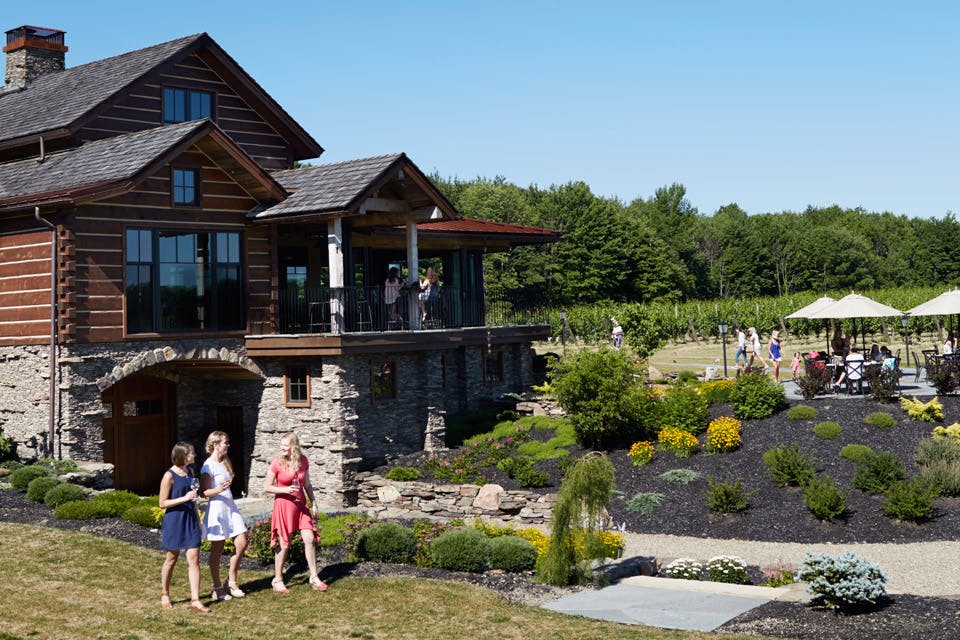4 Ohio Wineries We Love
Visit four destinations that provide a taste of what Ohio’s wine country has to offer.
August 2016 Issue
BY Staff & Contributors | Photo by Casey Rearick
August 2016 Issue
BY Staff & Contributors | Photo by Casey Rearick
Laurentia Vineyard & Winery | Madison
A dirt road flanked by neat rows of grape vines leads guests under Laurentia Vineyard & Winery’s towering entrance gate and along a meandering route shaded by a dense forest of lofty red oak and beech trees. The road ends at the winery’s tasting room, which would look at home in the pages of a vintage hunting catalog.
The log-and-stone construction gives the rustic, laid back feel of a lodge nestled along a Colorado stream, and the interior exudes the same appeal. Those pastoral qualities continue inside. Floors are made of reclaimed early 19th-century hickory wood, and the mount of a trophy elk hangs above the textured-stone, four-sided fireplace.
“Early on, it became apparent that I wasn’t just building a winery anymore,” says co-owner Leonard Blackie, who created the place with his brother, Gary Blackie. “I was building an attraction. From the last post, to the last rock, to the last fruit, no detail is overlooked. The wines are important, but everything else has to be top-notch.”
In 2009, Leonard and Gary first conceived the idea of opening a winery in Ohio’s Grand River Valley region during a hunting trip in Idaho. Upon their return, the two found 117 acres just minutes from Interstate 90 in Lake County’s tiny and peaceful Madison Township.
The brothers purchased the property in 2010 and harvested their first estate chardonnay three years later. It was also important to Leonard to maintain the property’s natural flow and characteristics, so he was careful to keep the forest intact while building the winery’s production facility and tasting room, which opened in July 2015.
The vineyard is named after Laurentia, the prehistoric North American land mass that was once covered by the Laurentide glacier. As the ice sheet retreated north back toward what is now Canada, its deposits created the fertile land that has made northeast Ohio the hub for viticulture it is today.
“This land has always been capable of producing world-class wines,” says Leonard. “You have great soil and clay from the land and the climate control from Lake Erie.”
With its hand-hewn beams, Laurentia Vineyard & Winery’s spacious tasting room was based on Gary’s fishing lodge in Colorado. Sliding barn doors reveal the kitchen, which offers a variety of seasonal dishes made from scratch, such as as a hand-thrown, three-cheese pizza, smoked salmon deviled eggs, pesto and chevre or a citrus fennel salad. The kitchen also hosts classes and demonstrations led by visiting wine experts and guest chefs.
Large windows surround the lodge’s main sitting area, letting in lots of natural light and allowing guests to take in the surrounding scenery year-round. The property’s stonework is meant to mimic the rocks of the nearby Grand River Valley Gorge.
Depending on the time of year, guests can curl up by the fireplace, hang out at one of the indoor or outdoor tables or even take a walk among the acres of chardonnay and riesling vines. Laurentia is also home to 43 acres of highly prized vinifera grapes necessary for pinot noir and cabernet sauvignon.
Hand-forged iron railings lead downstairs from the lodge’s main floor to Laurentia’s wine cellar, which offers a second bar and a view of the dozens of oak barrels which hold aged red wines and some chardonnays.
Behind glass, in a temperature-controlled room, 475-gallon cement tanks hold a 2014 Oregon chardonnay and 2014 riesling. Leonard explains that the use of concrete tanks during winemaking dates back to Roman times. Their porous nature allows the wines inside to breathe while imbuing them with minerality and a clean finish.
The wine cellar leads on to a wine library — a small, dimly lit room dedicated to Laurentia’s most exclusive vintages. The space also serves as a private tasting room that is available to customers by reservation.
“We concentrate on making the best wine possible out of a particular vintage or variety through great record-keeping, bench trials and always experimenting,” says Leonard. “For us, this is just the beginning.” — Andrew Poulsen
4599 S. Madison Rd., Madison 44057, 440/296-9175, laurentiawinery.com
***
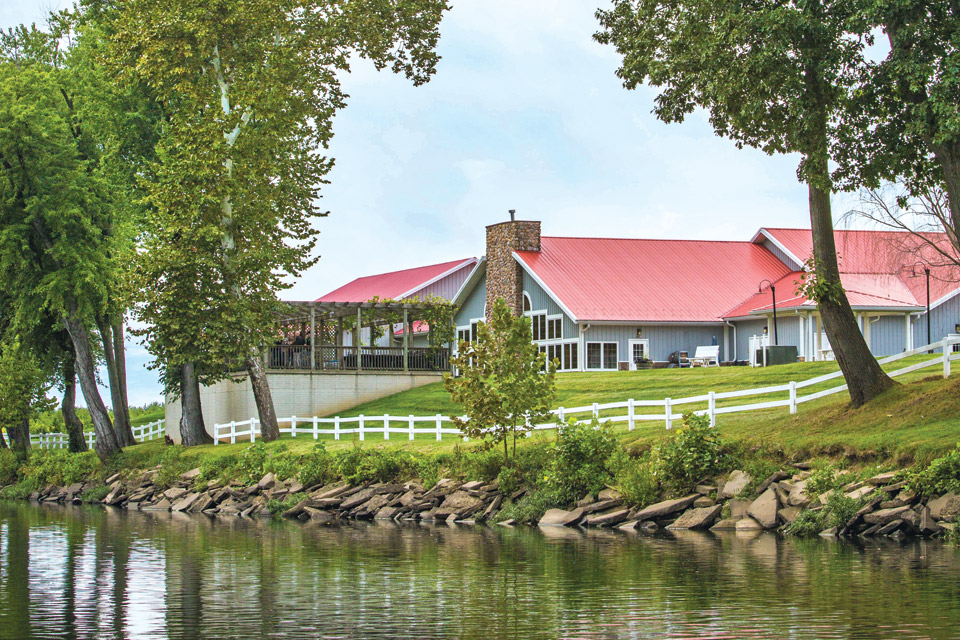
Raven’s Glenn Winery opened in 2003 and added a restaurant a year later. The tasting room provides a beautiful space for sampling. (photo by Laura Watilo Blake)
Raven’s Glenn Winery | West Lafayette
One doesn’t expect to find a pocket of Tuscan charm just a 10-minute drive from Interstate 77 in Coshocton County, but Raven’s Glenn Winery delivers it among the rolling Appalachian foothills.
Rows of grapevines stretch into the distance, and on a quiet day you can hear the gentle babble of the nearby Tuscarawas River from the parking lot. Inside the main restaurant and tasting room, guests find vaulted ceilings, a towering fireplace and picture windows offering views of the river and surrounding vineyard.
Current owners Beau and Tracy Guilliams bought Raven’s Glenn from Beau’s parents, Robert and Renee Guilliams, who started their first grape crop back in 1997. In the years since, the business has expanded to include more than 25 different wines — 15 of which have won awards — a wedding venue and a full-service restaurant.
“My father created a destination,” Beau says with a proud grin. The menu of mostly Italian fare has been developed to go well with Raven’s Glenn’s wine, and tasting flights are just $5 for 8 to 9 wines.
“We can teach you as much as you want,” says Beau. “Or if you and your significant other are having a weekend, and you want to spend time together, we’ll keep your glasses full.”
Although one would think such a business was the culmination of a lifelong dream, the way Beau tells it, it was more of a lemons-to-lemonade (or in this case grapes-to-wine) type of tale. Robert and Renee owned 100 acres up the hill from what is now Raven’s Glenn.
After long and fruitful careers in healthcare, Robert decided to look into growing a crop and called the local department of agriculture to see if they could recommend something.
“They looked at it, and they said, ‘Yeah … you can’t really grow anything here,” Beau recalls. But a week later, the department followed up with an unexpected proposition: grapes. Soon after, grape experts came and surveyed the property.
“They said everything here is perfect. It faces the right direction, the wind flows in the right direction, great drainage … ” Beau says. “[My dad] started learning more and more, and said, ‘OK, we’ll grow grapes then.’ ”
He and Renee got to work, and today there’s still a section of grapes on the vineyard called the “97 Block” from the first year they planted. After some experimentation, they chose three grape varieties to focus on: chardonel, vidal blanc and noiret. It took a few years, but by 2002 they had purchased the land by the Tuscarawas River where Raven’s Glenn now sits. In 2003, the winery opened for business, and the restaurant was added a year later.
“My father had a 10-year business plan that, at the end of 10 years, you would think he wrote it after the fact,” Beau says. “We talked through everything from when the place would open, to what we would serve, to when we were going to start distribution.”
When Raven’s Glenn first opened, yearly yield was around 2,500 gallons. That number has since steadily climbed to the current output of around 80,000 gallons.
The winery has also garnered multiple accolades. Raven’s Glenn’s R2 wine — an earthy, full-bodied red made entirely with noiret grapes grown at the vineyard and named in honor of Beau’s parents — won the distinction of being the Ohio Department of Agriculture’s best red wine for 2015.
“That I’m the proudest of,” Beau says. “It was the legacy my father wanted to leave behind.”
Besides expanding its wine output, Raven’s Glenn opened a banquet center in 2007 which has become a popular wedding and reunion venue. The winery also offers themed four-course wine-paired dinners throughout the year. The wild game dinner every March is one of their best-sellers. Despite all the growth, Beau says the goal here has never changed: Offer a beautiful setting, some great wine, a knowledgeable staff and absolutely zero pretention.
“Have fun, its just wine. Don’t make it tough,” Beau adds. “You drink it, you like it, it’s good.” — Rosie Haney
56183 County Rd. 143, West Lafayette 43845, 740/545-1000, ravensglenn.com
***
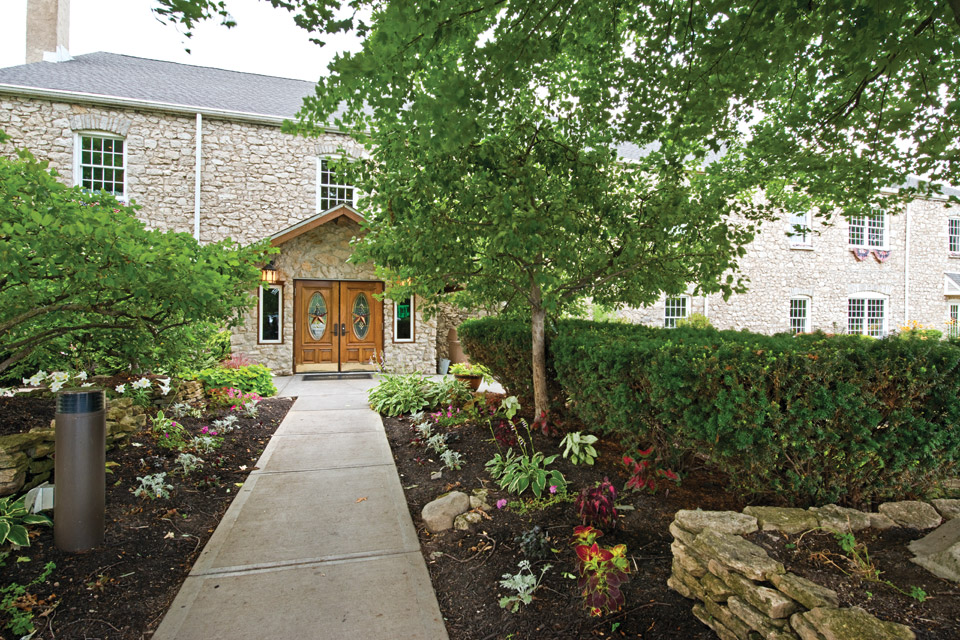
Mon Ami offers Old World charm. Pink Catawba is one of the winery’s popular varieties. (photo by Thom Sivo)
Mon Ami | Port Clinton
The welcoming words: Mon Ami, my friend, scrolled across the arched burgundy and gold entrance sign greet visitors to John and Peggy Kronberg’s Port Clinton winery. Nearby rose bushes grow as a nod to the vineyard’s tradition of planting the flowers along each row of grapes as a way to help promote vine health. At the end of the winery’s entrance walk, wooden doors open to a cool, stone cavern.
Inside, tucked away at one of the bar’s high-top table, John is looking over paperwork as Peggy and her bustling crew prepare for the evening’s events. Mon Ami is home to as many as seven weddings each weekend and other entertainment throughout the week, creating a place of constant movement. “We keep changing it, and it’s an evolution,” says John. “Every year, we reinvent ourselves … We try to change — not the brand — but what we do and how we do it.”
He and Peggy bought the historic 19th-century property in 2000. Once steeped in the chain-restaurant industry, Peggy and John traded pizzas and burgers for the quiet elegance of the historic manor. The stone building and surrounding grounds first churned out reds, whites and bubblies in 1872, when the building was used as a cooperative winery. (Mon Ami’s grapes are grown on North Bass Island, located a short ferry ride away.)
“Because of the lake, the season was extended longer, so they could have a longer season of growing,” says John.
The pink Catawba grape variety has been a regional favorite since winning the gold medal at the Brussels World’s Fair in the late 1800s. Mon Ami continues the tradition of making it, and John credits his Italian winemaker, Claudio Salvador, with the wine’s success.
“He knows how to grow grapes, he knows how to treat them properly, he knows how to make a great wine,” adds John. “I think the secret, if there is one, is the winemaker.”
When the Kronbergs first purchased Mon Ami, they had no background in winemaking, only a curiosity for the craft. John worked with winemakers to develop a residual sugar scale that is printed on the back of each bottle to guide novices and connoisseurs alike.
That accessibility is part of Mon Ami’s allure, but the place also exudes an elegance, with accents such as a granite, piano-shaped bar equipped with an ice inset to keep drinks cold. Antique red dining chairs from the 1950s grace the main dining room, and the building’s original wooden bar anchors a nearby sitting area.
Restaurant reservations are only accepted for holidays, but Mon Ami can — and does — accommodate large walk-in parties on a regular basis. Although French influences shape the winery’s name and look, the menu features upscale American cuisine with classics such as Alaskan crab and prime rib. The Saturday night seafood buffet is a favorite, drawing lines out the door.
A visit to the cellar of the original winery, which still houses 19th-century wine barrels, champagne-making equipment and original mortared grey stonework, provides a true taste of history. Guests can peer inside the massive dark barrels that line the walls. Barred windows scattered throughout the lower level also reflect the time when this part of the building was used as an underground prison and holding cell for Confederate soldiers during the Civil War, which has led to a few ghost stories over the years.
“You can see the bars on the windows from the old days of being a jail for the prisoners. The Confederate soldiers would have been in here,” says John. “I haven’t personally experienced any ghosts. Maybe because I don’t believe, they don’t come.” — Stephanie Grauer
3845 E. Wine Cellar Rd., Port Clinton 43452, 419/797-4445, monamiwinery.com
***
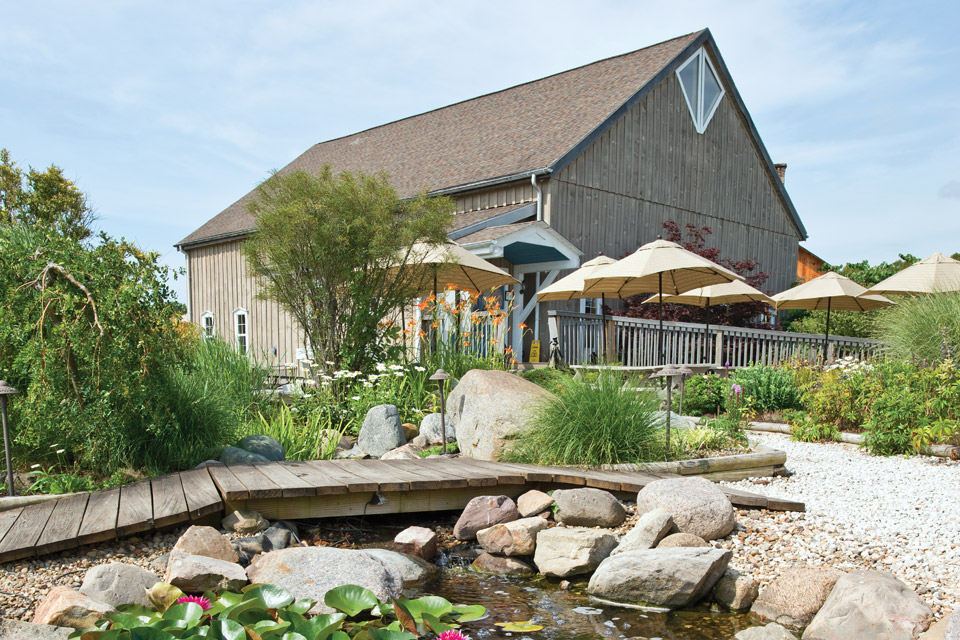
The patio and garden at Sarah’s Vineyard provide an inviting place to unwind. (photo by Thom Sivo)
Sarah’s Vineyard | Cuyahoga Falls
The summer drive to Sarah’s Vineyard includes a glimpse of Cuyahoga Valley National Park at the peak of its beauty. Those approaching from the west can opt to wind through the river valley, passing by lands that housed small working farms more than a century ago and do again, thanks to an initiative that is helping the area embrace its agricultural roots.
Sarah’s Vineyard sits on 15 acres on the edge of the valley, across the street from the entrance to Blossom Music Center, and offers views of the sprawling forest. The winery is housed in an 1854 barn that was moved to the site and completes the rural atmosphere that Mike and Margaret Lytz hoped to achieve when they starting planning their vineyard in 2001.
“Somehow I always knew I was going to have a winery someday,” says Mike. He first learned how to make wine with his grandfather and then carried the tradition into adulthood. He even saved scraps of wood with plans to build a walnut bar. “People would roll their eyes … say, ‘Yeah, sure.’ ”
But the story behind Sarah’s Vineyard is one that has been shaped by heartbreak. Guests visiting the main tasting room will notice an ornately framed photo of a young woman: Margaret Lytz’s daughter, Sarah.
As Mike reads the plaque under the portrait, the sound of held-back tears accumulates in his voice: “The vineyard is named after Margaret’s late daughter, Sarah, who died in a tragic car accident in 1998. The fields are cared for in her memory. We feel the name is a good fit for the land, for as seasons come and go, Sarah’s Vineyard will reshape the abandoned fields into the image of a countryside once lost — but not forgotten.”
He takes a moment and briefly sighs, “It’s a way of keeping her memory alive.”
Looking around at the warm, wood interior, the art on the walls and the large patio overlooking the grapevines outside, it’s clear how much care and attention has been put into every aspect of the winery. It’s impossible not to be moved.
Mike, a retired schoolteacher and coach from Akron Public Schools, says he and Margaret had one big obstacle to making the winery a reality: getting the land. A schoolteacher’s salary doesn’t leave much room for large investments, but when he learned of a Cuyahoga Valley National Park initiative to bring agriculture back to the 33,000 acres between Cleveland and Akron, he jumped at the opportunity.
Considering the National Park Service prohibits alcohol, Mike knew a vineyard would be a long shot, but he made his proposal anyway. After a demanding application process, the grant was awarded on the third anniversary of Sarah’s death. In the years following, Mike and Margaret got to work developing the land, cultivating their crop and acquiring the necessary equipment before opening their winery in 2007.
Over the years, the Lytzes added a butterfly garden, a food menu stacked with appetizers, sandwiches and wood-fired pizzas, a Summer Solstice Festival, live entertainment every Wednesday during the winter and an art gallery. Last year also brought the addition of a large pavilion and a 32-foot outdoor fireplace.
As Mike names the vineyard’s six staple wines: Blue Heron, Golden Solstice, Sarah’s Secret, Miserabile, Cuyahoga Valley Reserve and Sweet Elisa, he notes that the latter — an estate-grown blush named after his daughter Elisa — is their best-seller. “It’s sweet but not too sweet,” he jokes. “I think a lot of parents can relate to that.”
Love abounds at Sarah’s Vineyard, from the meticulously tended vines to the art Margaret chooses for the walls. All serve as a tribute not just to Sarah but also to the power of connection. It’s one of the reasons general manager Sarah Altieri was drawn to the place.
“I remember seeing the line on the wall: ‘All because two people fell in love,’ ” she says before pausing for a moment. “It just stuck with me.” — RH
1204 W. Steels Corners Rd., Cuyahoga Falls 44223, 330/929-8057, sarahsvineyardwinery.com
Related Articles

3 Ways to Explore Lake County this Summer
This northeast Ohio county may be the smallest in the state, but what it lacks in size it makes up for in lakefront fun, small-town experiences and great wineries. READ MORE >>

Ohio Wine Month: Celebrating Our State’s Winemakers
The start of summer means exploring the winemakers across our state. Here are four spots that offer a flavor of our state’s offerings and a guide to help you plan your travels. READ MORE >>
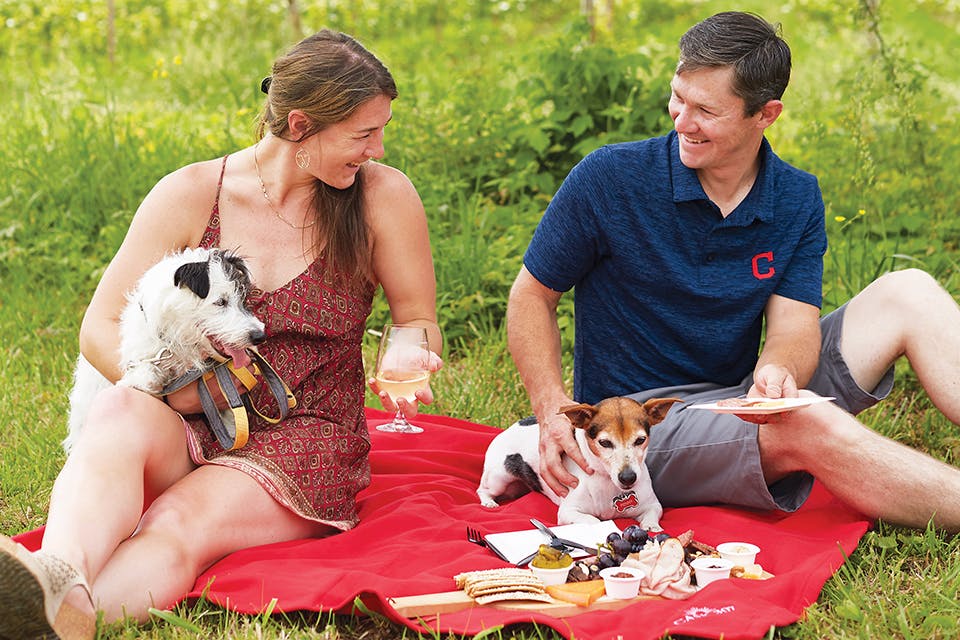
Ohio Wine Month 2023: 7 Wineries to Visit this Summer
From the foothills of Appalachia to the islands of Lake Erie, Ohio produces a wide selection of wines. READ MORE >>


